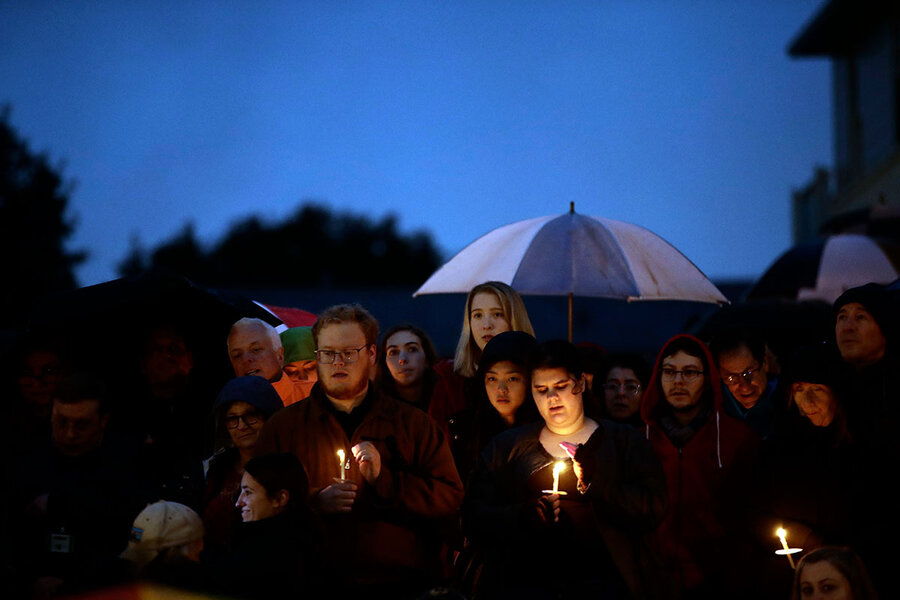Are mass shootings doomed to be America’s ‘new normal’? ‘That is a myth.’
| Sacramento, Calif.
The satirical online publication The Onion has posted the same short piece in the aftermath of several of the country’s worst mass shootings since 2014. The story includes details about the latest spasm of gun violence – where it occurred, the number of victims – followed by a quote from a fictional Midwestern resident.
“This was a terrible tragedy, but sometimes these things just happen and there’s nothing anyone can do to stop them,” the quote reads in each version of the story. “It’s a shame, but what can we do?”
The item ran again last week after a gunman killed a dozen people and wounded 18 at a country music bar in Thousand Oaks, Calif. — the second time it appeared in less than two weeks. The Onion had last posted the piece after a man shot and killed 11 people and wounded seven Oct. 27 at a synagogue in Pittsburgh, Pa.
The story’s repeated publication and dark humor capture at once the alarming frequency of mass shootings nationwide and the sense of futility that can afflict Americans when the stark headlines and troubling images again flood the news cycle. Yet if in that moment readers and viewers feel trapped in a new, intractable normal, the results of last week’s midterm election suggest that a growing number of voters want to confront rather than retreat from the gun violence epidemic.
Democrats in congressional races defeated more than a dozen Republicans who hold an “A” rating from the National Rifle Association (NRA), including longtime Reps. Mike Coffman of Colorado and Pete Sessions of Texas. In Georgia, Democratic candidate Lucy McBath, a prominent gun-control activist who lost her son in a fatal shooting in 2012, ousted Rep. Karen Handel, the Republican incumbent. A ballot measure to dramatically tighten Washington State’s gun policies passed by a wide margin, and across the country, 60 percent of voters who headed to the polls favor strengthening gun laws.
“There’s a popular assumption that these horrible shootings happen and then nothing changes. That is a myth,” says Kristin Goss, a professor of public policy at Duke University and co-author of “The Gun Debate,” a 2014 book that examines gun violence and its potential prevention.
The push for gun reform has gained velocity as disparate blocs of advocates – high school students, parents, trauma surgeons – join the crusade. For Garen Wintemute, an emergency room physician and director of the Firearm Violence Research Center at the University of California, Davis, the midterms offered evidence of a shift in strategy to break the inertia in Congress on gun reform.
“We need to give up thinking we can change policy with policymakers who were elected with support of the NRA,” Dr. Wintemute says. “What we need to do is get different policymakers.”
Gun violence prevention groups advanced that cause in this year’s election. Candidates endorsed by Everytown for Gun Safety, founded by former New York Mayor Michael Bloomberg, won 46 of 57 congressional races. Everytown and Giffords – a group founded by former Democratic Rep. Gabrielle Giffords, who was gravely wounded in a 2011 mass shooting – spent a combined $11.8 million on the 2018 campaign, or $2.4 million more than the NRA.
Changes at the state level
The success of candidates who back gun control would appear to contradict The Onion’s portrayal of a numbed nation. George Bonanno, a professor of psychology at Columbia University, regards the surging support for reform as a signal that Americans are less fatalistic about gun violence than the fleeting media coverage of mass shootings might convey.
“The way human beings react to extreme stress is that we compartmentalize. We try to stop thinking about things,” says Professor Bonanno, who heads the university’s Loss, Trauma, and Emotion Lab, where researchers study how people cope with extreme life events. “But that doesn’t mean we forget about them entirely. We can decide to take action and vow to change something without dwelling on it to the point that it becomes debilitating.”
A litany of mass shootings in recent years has yielded a grim shorthand in which the names of cities conjure memories of gun violence: Aurora, Colo.; Newtown, Conn.; Las Vegas; Sutherland Springs and Santa Fe, Texas; Orlando and Parkland, Fla.
Two days after the Thousand Oaks massacre, the Centers for Disease Control and Prevention (CDC) reported that, following a decade of decline, the national rate of gun-related homicides had reached its highest level since 2006.
Nearly 27,400 homicides involving firearms occurred in 2015-16, the latest period studied, a rate of 4.4 per 100,000 people and an increase of almost 4,600 deaths over 2012-13. During the same span, suicides by gun climbed by more than 3,100 to nearly 45,000.
The report’s authors describe firearm homicides and suicides as “a continuing public health concern in the United States.” The day-to-day toll of gun violence, brought into painful focus by mass shootings, has created momentum for states to fortify gun laws as federal legislation stalls in Congress year after year.
So far this year, there have been 11 mass shootings in which three or more people died, according to a Mother Jones database. (A more commonly cited statistic of more than 300 is attributed to the Gun Violence Archive, which defines a mass shooting as four or more people killed or wounded.)
In March, Florida lawmakers approved the Marjory Stoneman Douglas High School Public Safety Act, one month after a former student gunned down 17 people at the school in Parkland. The initiative raised the legal age to buy a firearm from 18 to 21 and created waiting periods and background checks for gun purchases. The bill passed in a state where Republicans control both legislative chambers and where Republican Gov. Rick Scott held an “A+” rating from the NRA until he signed the measure. (The gun rights group then knocked him down to a “C.”)
Before the Parkland shooting, five states had enacted so-called red flag laws that enable a judge to order temporary removal of firearms from people who pose a threat to themselves or others. In the ensuing months, Florida and seven other states passed similar legislation.
Dr. Goss has researched gun violence in America since two students killed 13 people at Columbine High School in Colorado in 1999. She considers the Washington ballot measure and the actions of Florida legislators – who responded, in part, to pressure from Parkland student activists – hopeful signs that policy reforms will continue to take root by other means if efforts wither in Congress.
“It’s a big country with multiple levels of government,” she says. “If one is locked down, you can work on other levels.”
The $9.4 million that the NRA contributed to campaigns this year marked a drop of almost two-thirds from its spending in the 2014 midterms.
In election post-mortems, the group has emphasized its impact in Senate races, touting the victories of gun rights activist Marsha Blackburn in Tennessee and Republican Josh Hawley in Missouri. Those results “were key to growing the pro-Second Amendment majority in the Senate, which will ensure the confirmation of federal judicial appointees who respect the Second Amendment,” an NRA spokeswoman told The New York Times.
'Stay in your lane'
The group further dispelled perceptions that it would pull back from the clash over firearms when it attacked doctors who advocate for treating gun violence as a public health problem. Responding to a position paper published in the Annals of Internal Medicine by the American College of Physicians, the NRA posted a tweet that read: “Someone should tell self-important anti-gun doctors to stay in their lane. Half of the articles in Annals of Internal Medicine are pushing for gun control. Most upsetting, however, the medical community seems to have consulted NO ONE but themselves.”
The comment drew furious replies from physicians across the country under the hashtags #ThisIsMyLane and #ThisIsOurLane. They posted photos that showed the aftermath of operating on gunshot victims — blood-stained emergency room floors and surgical scrubs — and shared details about some of those patients, including children as young as 6 months old.
The public rejoinder from doctors and the ascendance of gun control candidates in the midterms provide at least two potential answers to the question – “It’s a shame, but what can we do?” – posed by The Onion’s fictional Midwesterner. Wintemute, the emergency room doctor, asserts that changing the culture will require collective resolve.
“What happened in Thousand Oaks was another ‘It can’t happen here’ tragedy like Newtown, like Aurora, like so many others,” he says. “Everyone has to understand that this could happen to them, to their children, to their grandchildren. And then everyone has to ask, ‘What am I willing to do to keep it from happening again?’ ”







